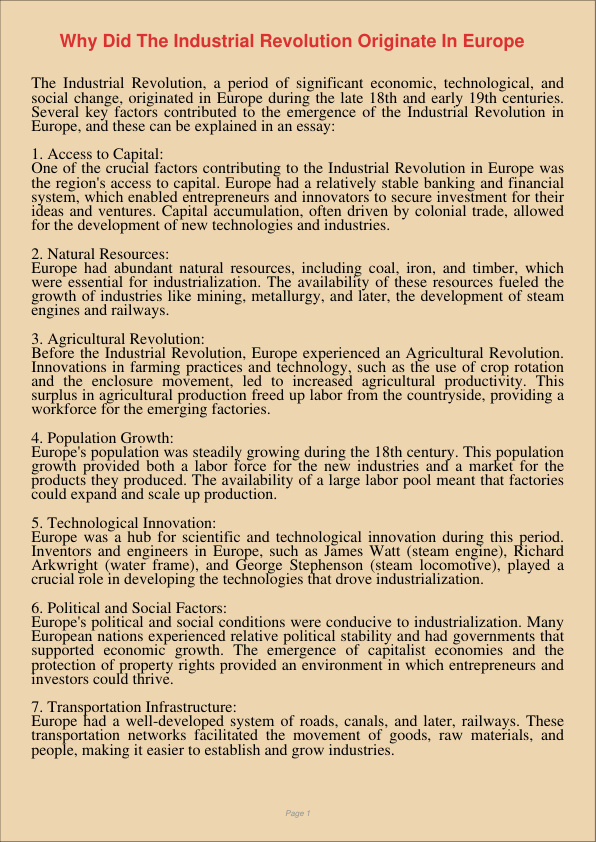Why Did The Industrial Revolution Originate In Europe
Jan 6, 2024
industrial revolution originate
europe
Law
Health Sciences & Medicine

The Industrial Revolution, a period of significant economic, technological, and social change, originated in Europe during the late 18th and early 19th centuries. Several key factors contributed to the emergence of the Industrial Revolution in Europe, and these can be explained in an essay:
-
Access to Capital: One of the crucial factors contributing to the Industrial Revolution in Europe was the region’s access to capital. Europe had a relatively stable banking and financial system, which enabled entrepreneurs and innovators to secure investment for their ideas and ventures. Capital accumulation, often driven by colonial trade, allowed for the development of new technologies and industries.
-
Natural Resources: Europe had abundant natural resources, including coal, iron, and timber, which were essential for industrialization. The availability of these resources fueled the growth of industries like mining, metallurgy, and later, the development of steam engines and railways.
-
Agricultural Revolution: Before the Industrial Revolution, Europe experienced an Agricultural Revolution. Innovations in farming practices and technology, such as the use of crop rotation and the enclosure movement, led to increased agricultural productivity. This surplus in agricultural production freed up labor from the countryside, providing a workforce for the emerging factories.
-
Population Growth: Europe’s population was steadily growing during the 18th century. This population growth provided both a labor force for the new industries and a market for the products they produced. The availability of a large labor pool meant that factories could expand and scale up production.
-
Technological Innovation: Europe was a hub for scientific and technological innovation during this period. Inventors and engineers in Europe, such as James Watt (steam engine), Richard Arkwright (water frame), and George Stephenson (steam locomotive), played a crucial role in developing the technologies that drove industrialization.
-
Political and Social Factors: Europe’s political and social conditions were conducive to industrialization. Many European nations experienced relative political stability and had governments that supported economic growth. The emergence of capitalist economies and the protection of property rights provided an environment in which entrepreneurs and investors could thrive.
-
Transportation Infrastructure: Europe had a well-developed system of roads, canals, and later, railways. These transportation networks facilitated the movement of goods, raw materials, and people, making it easier to establish and grow industries.
-
Trade and Colonialism: Europe’s extensive overseas empires provided access to raw materials, new markets, and wealth. The profits from colonial trade and the influx of wealth from the colonies further fueled the European economy, enabling investments in industrial enterprises.
In summary, the Industrial Revolution in Europe can be attributed to a combination of factors that included access to capital, abundant natural resources, agricultural innovations, a growing population, technological progress, political stability, and well-developed transportation infrastructure. Europe’s favorable economic, political, and social conditions provided the fertile ground for the rapid and widespread adoption of industrial technologies, ultimately giving birth to the profound transformations associated with the Industrial Revolution.